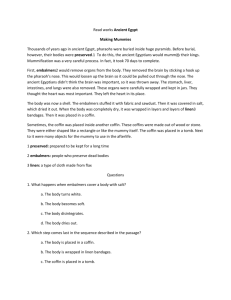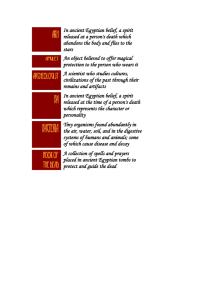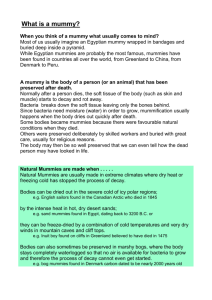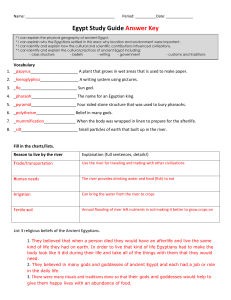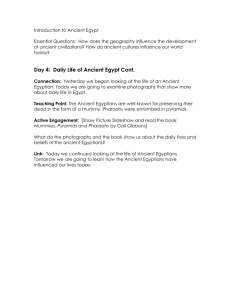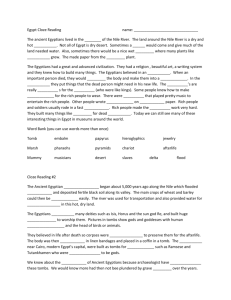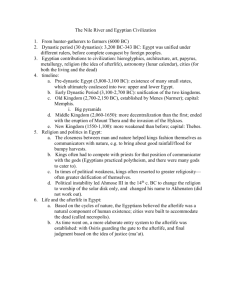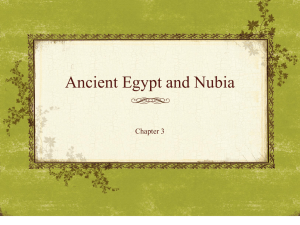File
advertisement
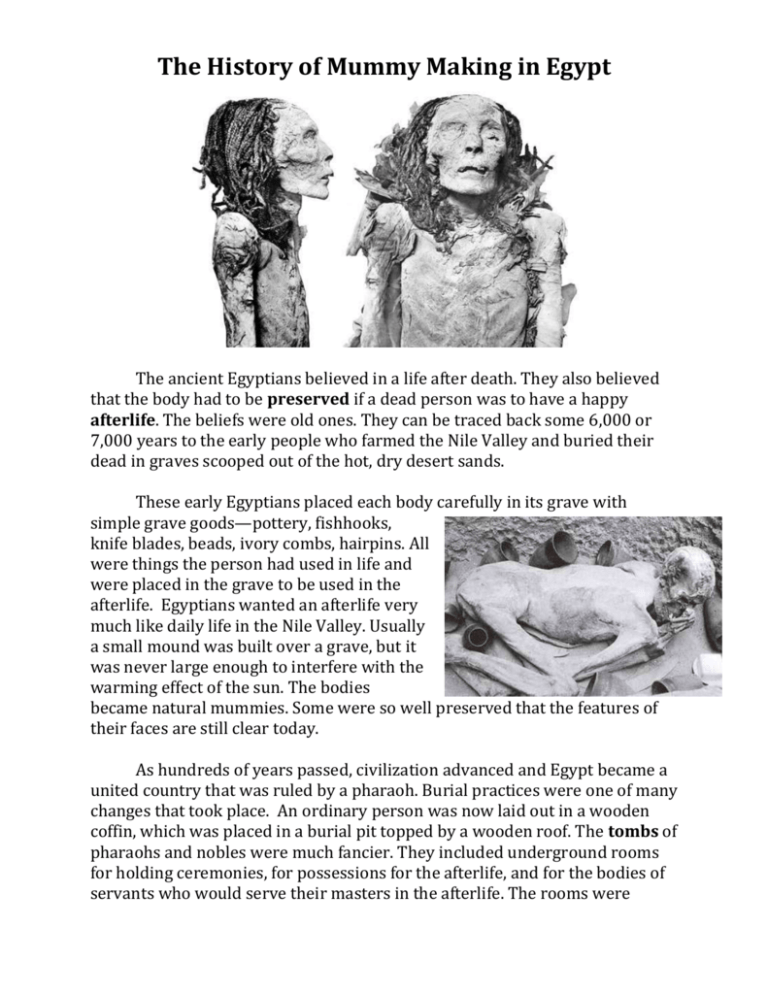
The History of Mummy Making in Egypt The ancient Egyptians believed in a life after death. They also believed that the body had to be preserved if a dead person was to have a happy afterlife. The beliefs were old ones. They can be traced back some 6,000 or 7,000 years to the early people who farmed the Nile Valley and buried their dead in graves scooped out of the hot, dry desert sands. These early Egyptians placed each body carefully in its grave with simple grave goods—pottery, fishhooks, knife blades, beads, ivory combs, hairpins. All were things the person had used in life and were placed in the grave to be used in the afterlife. Egyptians wanted an afterlife very much like daily life in the Nile Valley. Usually a small mound was built over a grave, but it was never large enough to interfere with the warming effect of the sun. The bodies became natural mummies. Some were so well preserved that the features of their faces are still clear today. As hundreds of years passed, civilization advanced and Egypt became a united country that was ruled by a pharaoh. Burial practices were one of many changes that took place. An ordinary person was now laid out in a wooden coffin, which was placed in a burial pit topped by a wooden roof. The tombs of pharaohs and nobles were much fancier. They included underground rooms for holding ceremonies, for possessions for the afterlife, and for the bodies of servants who would serve their masters in the afterlife. The rooms were roofed over and covered above ground by large buildings made of mud bricks, which looked like palaces or fortresses. The changes created a problem. Before burial, bodies were carefully wrapped in strips of linen. But while the bandaging preserved the shape of the body, it did not preserve the body itself. Neither did the tomb, because the body was no longer dried by the desert sand. In addition, the dampness of the tomb encouraged bacteria and decay. The decay forced the ancient Egyptians to search for ways to treat bodies so that they would be preserved in their tombs without decay. Exactly what they did in the beginning is not clear, because they were not very successful at first. Archeologists have found parts of bodies, such as the bones of an arm wrapped in linen and decorated with jewelry. But clearly the first steps Egyptians took were not working. The first evidence of successfully creating mummies comes from around 2600 B.C. Embalmers, who prepared bodies for burial, had taken two giant steps forward. They had learned to remove from a body the parts that would decay most swiftly—the stomach, intestines, liver, and lungs. They also realized that a body needed to be dried out, and they found a way to do this by using a material called natron. Natron is a kind of salt that occurs naturally in Egypt. The embalmers used natron to preserve the bodies. They also used it to preserve the organs they removed, which were placed in stone jars, called canopic jars, for burial in the tomb. Once the process was successful, embalming became an art—practiced in booths set up along the banks of the Nile River. A treated body turned out to be little more than a skeleton covered with leathery skin. Around 2400 B.C., embalmers began trying to make the body look more as it had in life. They molded a shell of linen and plaster over the body and painted it in lifelike colors. Later some embalmers used resin. They melted this sticky stuff, which came from trees and poured it over the body to form a shell. As it happened, the resin sealed out bacteria and moisture which helped preserve the body. This was the start of mummy making in Egypt, and the ancient Egyptians went on making mummies for another 3,000 years! Egyptians stopped making mummies around 500 A.D. because most people were starting to adopt Christianity as their religion. In this faith the body did not have to be preserved to ensure eternal life. So the practice of mummy making ended. People were simply buried in the clothes they had worn in their life. The art of embalming reached its peak during a period known as the New Kingdom (1570 – 1070 B.C.). Many beautifully preserved bodies have survived from this period. Yet is has taken modern scientists years to work out how the bodies were treated. The main reason scientists could not figure out how mummies were made is that no written records exist of the process. The only written accounts of mummifying come from foreigners who visited Egypt at the time. There is no way to know if their telling of the process is accurate. To learn about mummy making in ancient Egypt, scientists have looked for evidence from the mummies themselves. Using clues from these studies, scientists have set up experiments to see if they too could create mummies. Based on the foreign accounts and experiments, scientists believe there were several basic steps in creating a mummy. First, embalmers removed inner organs and preserved them. By the time of the New Kingdom, embalmers were also removing the brain, usually through the nose with a hooked metal rod. They washed the inside of the body with palm wine which killed bacteria. They dried the body by packing it in dry natron for 40 days. Then they coated it with oils. The ancient Egyptians believed that a person's soul had 5 parts. Two parts, the Ka, the energy force, and the Ba, the personality, left the physical body at the time of death. But they also believed that the Ka and Ba could be lured back if a recreation of the body was offered. This re-unification of body and soul was the ticket to the nether world. To make sure the Ba and Ka could find the body, which by now looked like a withered prune, a beautification process was necessary. The skin of the corpse was massaged to make it supple, the body was stuffed and perfumed, and padding was slipped under the skin to approximate plump flesh. Finally, rouge and other paints were applied. The last step was to coat the mummy in warm resin and wrap it from head to foot in layer after layer of linen strips. About 150 yards—the length of one and a half football fields—were used. Together with religious ceremonies, the whole process took 70 days. By 1200 B.C. another change took place. The embalmed internal organs were no longer buried in stone jars but were stuffed back into the body. The ancient Egyptians mummified animals as well as human beings. Some pets were mummified because they were dearly loved and were to keep their owners company in the afterlife. Another reason is that some were mummified for religious reasons. The Egyptians worshipped many gods and believed that certain animals represented the god in earthly forms. Apparently, certain individual animals were viewed as sacred; these were treated royally and given royal funerals after mummification. Other animal mummies seem to hare been offerings to the gods. The cat-goddess, Bastet, had a huge following. Pilgrims bought mummified cats to offer to the goddess at her shrines. Large cemeteries filled with cat mummies have been found near these shrines. During the periods when it flourished in ancient Egypt, embalming was both an art and a science. It's estimated that over a 3000-year period, more than 70 million mummies were made in Egypt. The skill with which embalmers worked can be seen in mummies that have lasted thousands of years and now give scientists a window on life in ancient Egypt.
